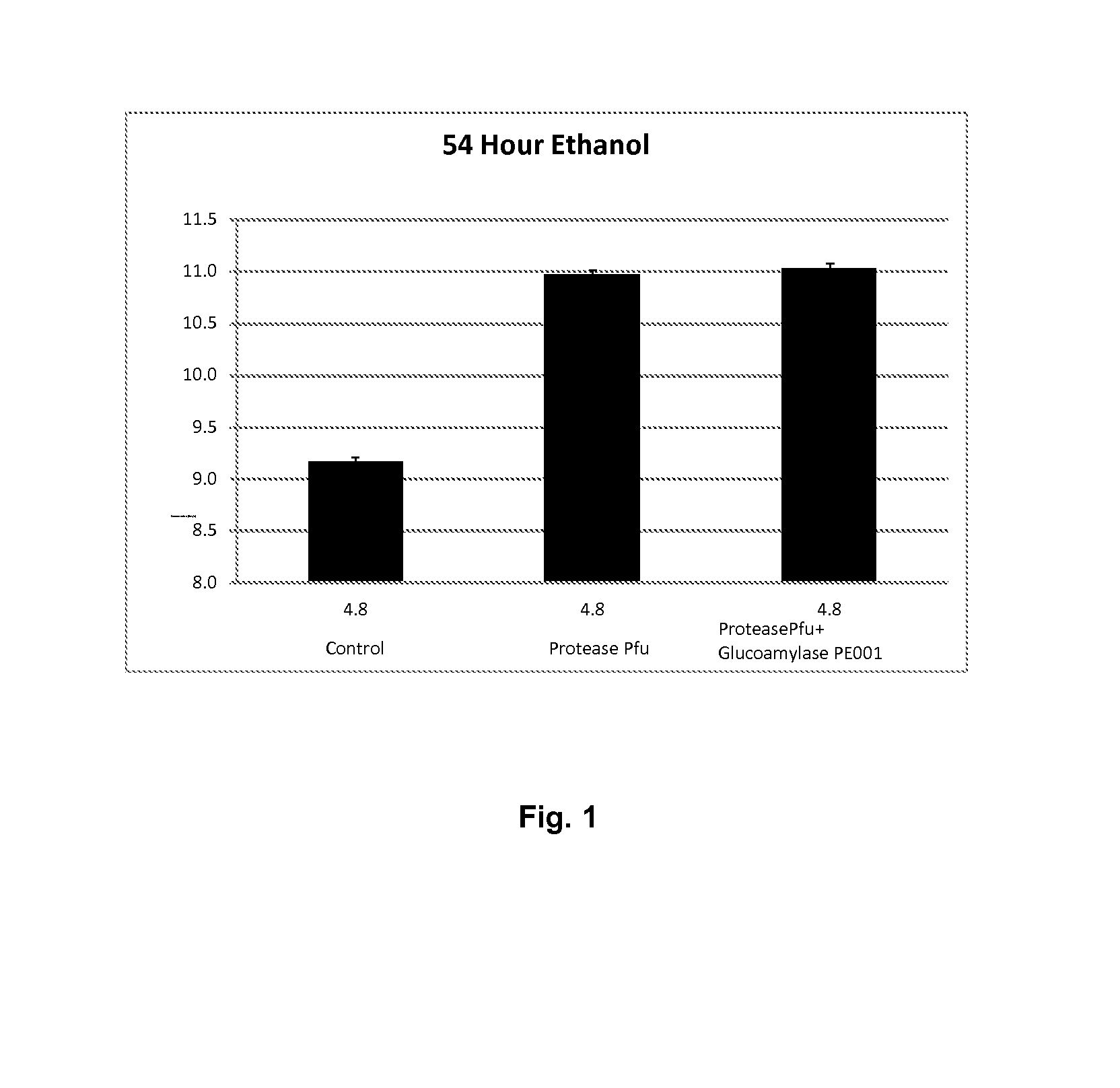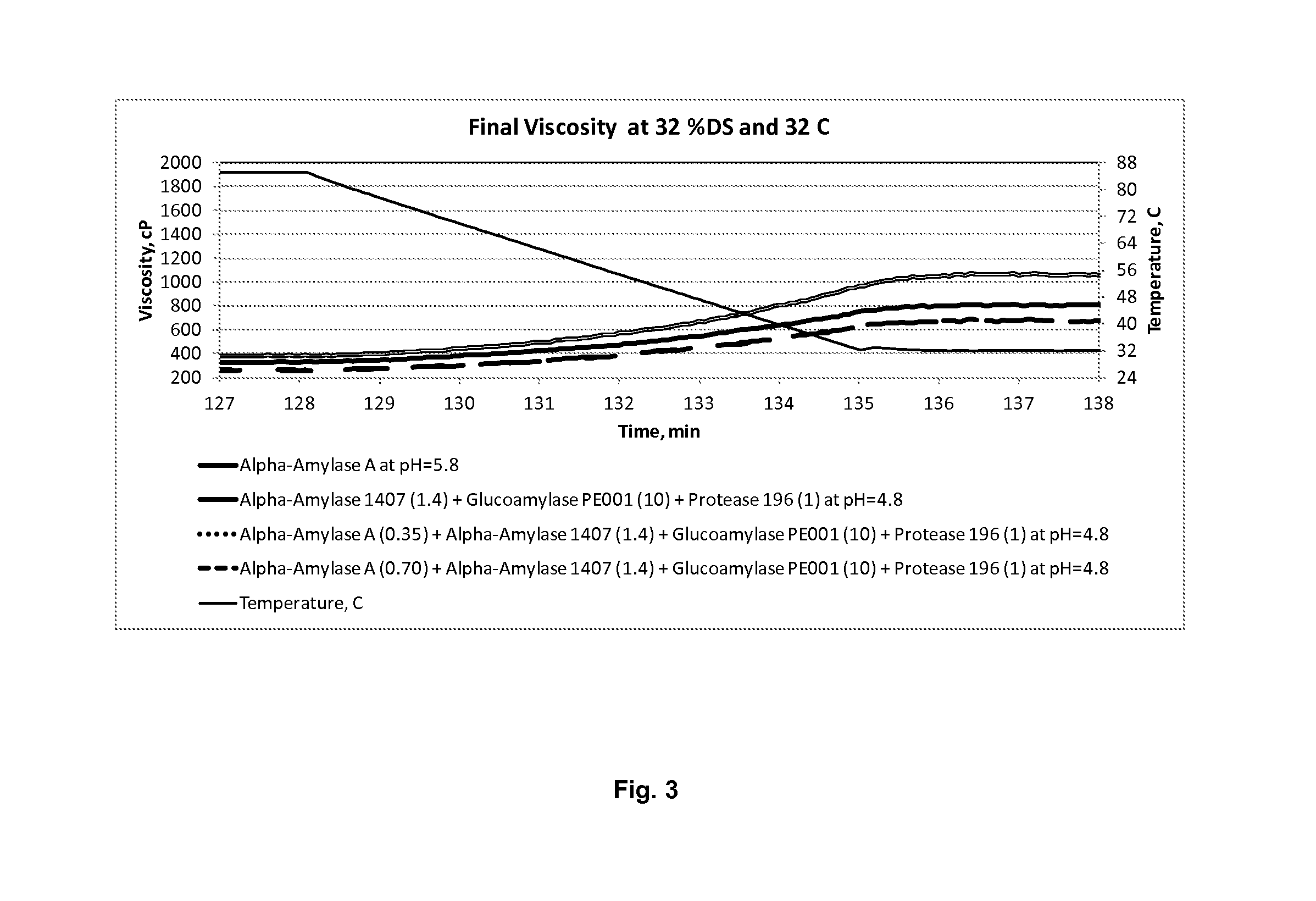Processes for Producing Fermentation Products
a technology of fermentation products and processes, applied in the field of production processes of fermentation products, can solve the problem that a significant amount of residual starch material cannot be converted into the desired fermentation product, and achieve the effect of improving the quality of the produ
- Summary
- Abstract
- Description
- Claims
- Application Information
AI Technical Summary
Benefits of technology
Problems solved by technology
Method used
Image
Examples
example 1
Stability of Alpha-Amylase Variants
[0256]The stability of a reference alpha-amylase (Bacillus stearothermophilus alpha-amylase with the mutations I181*+G182*+N193F truncated to 491 amino acids (SEQ ID NO: 1)) and alpha-amylase variants thereof was determined by incubating the reference alpha-amylase and variants at pH 4.5 and 5.5 and temperatures of 75° C. and 85° C. with 0.12 mM CaCl2 followed by residual activity determination using the EnzChek® substrate (EnzChek® Ultra Amylase assay kit, E33651, Molecular Probes).
[0257]Purified enzyme samples were diluted to working concentrations of 0.5 and 1 or 5 and 10 ppm (micrograms / ml) in enzyme dilution buffer (10 mM acetate, 0.01% Triton X100, 0.12 mM CaCl2, pH 5.0). Twenty microliters enzyme sample was transferred to 48-well PCR MTP and 180 microliters stability buffer (150 mM acetate, 150 mM MES, 0.01% Triton X100, 0.12 mM CaCl2, pH 4.5 or 5.5) was added to each well and mixed. The assay was performed using two concentrations of enzyme...
example 2
Preparation of Protease Variants and Test of Thermostability
[0261]Chemicals used were commercial products of at least reagent grade.
Strains and Plasmids:
[0262]E. coli DH12S (available from Gibco BRL) was used for yeast plasmid rescue. pJTP000 is a S. cerevisiae and E. coli shuttle vector under the control of TPI promoter, constructed from pJC039 described in WO 01 / 92502, in which the Thermoascus aurantiacus M35 protease gene (WO 03 / 048353) has been inserted.
[0263]Saccharomyces cerevisiae YNG318 competent cells: MATa Dpep4[cir+] ura3-52, leu2-D2, h is 4-539 was used for protease variants expression. It is described in J. Biol. Chem. 272(15): 9720-9727 (1997).
Media and Substrates
[0264]10× Basal solution: Yeast nitrogen base w / o amino acids (DIFCO) 66.8 g / L, succinate 100 g / l, NaOH 60 g / l.
SC-glucose: 20% glucose (i.e., a final concentration of 2%=2 g / 100 mL)) 100 mL / L, 5% threonine 4 mL / L, 1% tryptophan 10 ml / 1, 20% casamino acids 25 ml / 1, 10× basal solution 100 ml / 1. The solution is s...
example 3
[0295]Temperature Profile of Selected Protease Variants Using Purified Enzymes
[0296]Selected protease variants showing good thermostability were purified and the purified enzymes were used in a zein-BCA assay as described below. The remaining protease activity was determined at 60° C. after incubation of the enzyme at elevated temperatures as indicated for 60 min.
Zein-BCA Assay:
[0297]Zein-BCA assay was performed to detect soluble protein quantification released from zein by variant proteases at various temperatures.
Protocol:
[0298]1) Mix 10 microL of 10 micro g / mL enzyme solutions and 100 microL of 0.025% zein solution in a micro titer plate (MTP).[0299]2) Incubate at various temperatures for 60 min.[0300]3) Add 10 microL of 100% trichloroacetic acid (TCA) solution.[0301]4) Centrifuge MTP at 3500 rpm for 5 min.[0302]5) Take out 15 microL to a new MTP containing 100 microL of BCA assay solution (Pierce Cat#:23225, BCA Protein Assay Kit).[0303]6) Incubate for 30 min. at 60° C.[0304]7) ...
PUM
| Property | Measurement | Unit |
|---|---|---|
| Temperature | aaaaa | aaaaa |
| Temperature | aaaaa | aaaaa |
| Temperature | aaaaa | aaaaa |
Abstract
Description
Claims
Application Information
 Login to View More
Login to View More - R&D
- Intellectual Property
- Life Sciences
- Materials
- Tech Scout
- Unparalleled Data Quality
- Higher Quality Content
- 60% Fewer Hallucinations
Browse by: Latest US Patents, China's latest patents, Technical Efficacy Thesaurus, Application Domain, Technology Topic, Popular Technical Reports.
© 2025 PatSnap. All rights reserved.Legal|Privacy policy|Modern Slavery Act Transparency Statement|Sitemap|About US| Contact US: help@patsnap.com



